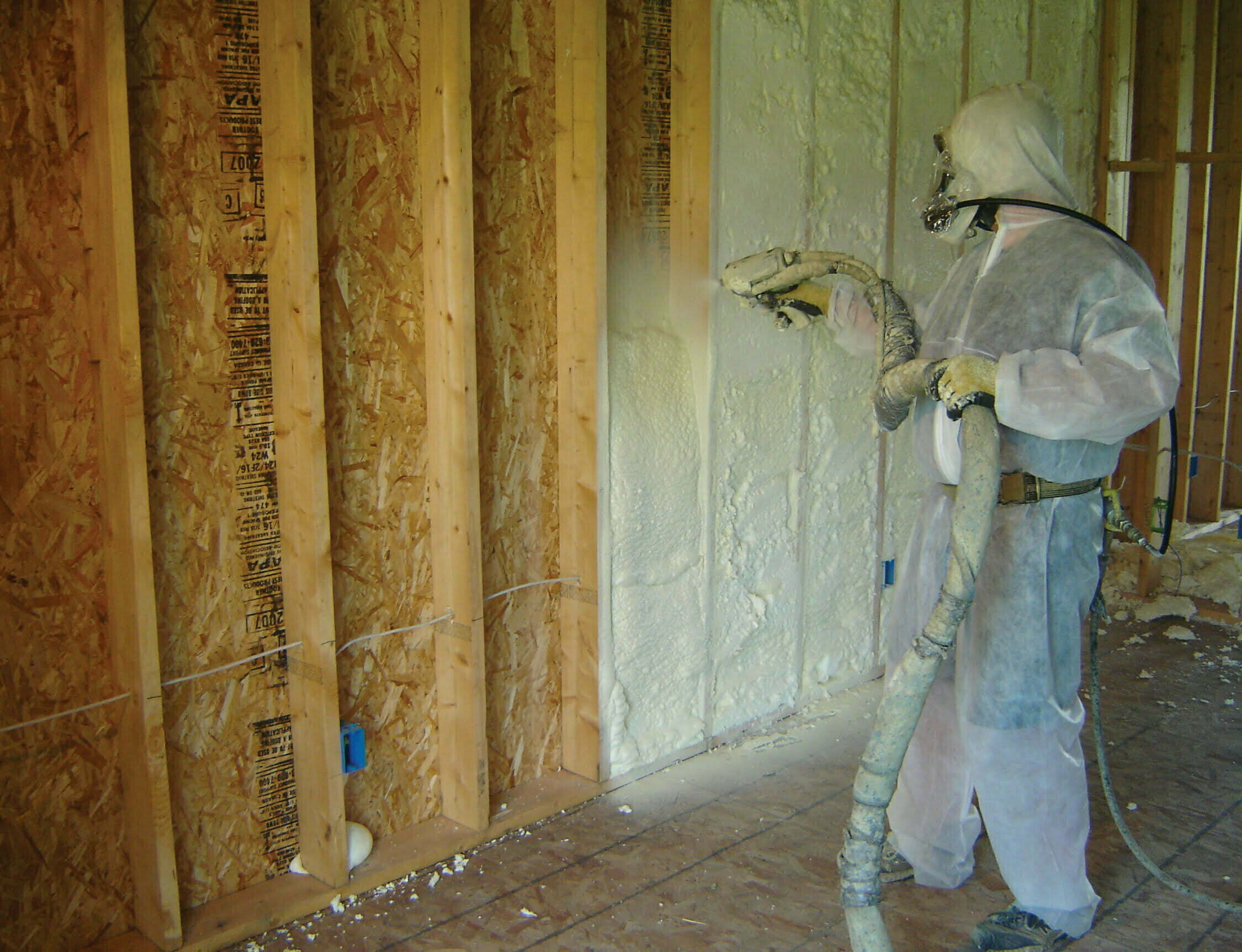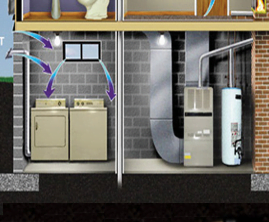Spray foam insulation offers a superior way to transform your basement by insulating walls, blocking moisture, preventing mold growth, and enhancing energy efficiency. If you’ve been thinking about installing new insulation in your cellar, learn how you can transform your home with spray foam basement walls.
Understanding the Basics of Spray Foam Insulation
Insulating your basement can seem like a major undertaking. But with the right material and tools, it can significantly boost your home’s comfort and energy efficiency. When you choose spray foam insulation installed by qualified professionals, the process is simple, and the benefits are plentiful.
What is Spray Foam Insulation?
Simply put, spray foam insulation is a polyurethane material that expands upon installation to provide an air seal and insulator. Installed using a special spray foam gun that combines two liquid components, this foam hardens to add a layer of insulation, guarding against heat loss and mold growth while ensuring air sealing.
Benefits of Using Spray Foam Insulation in Basements
Properly installed spray foam insulation in basement walls provides a wide range of benefits for homeowners.
- Improved energy efficiency and reduced energy bills: Spray foam has a high R-value per inch, allowing it to insulate well even with a thinner application. This helps reduce heat loss through basement walls and ceilings, lowering energy usage for heating and cooling.
- Increased building durability: Spray foam bonds tightly to surfaces, sealing cracks and gaps that allow air and moisture movement. This protects building materials from water damage, rot, and pests.
- Avoidance of air leakage: The airtight seal of spray foam prevents drafts and infiltration through cracks. This improves indoor air quality and temperature regulation.
- Reduction of condensation and mold growth: By limiting moisture transfer, spray foam minimizes condensation on walls and ceilings. This prevents conditions that lead to mold growth.
- Control of humidity levels: Spray foam does not absorb or transmit moisture readily, helping regulate interior humidity. This creates a more comfortable environment.
- Resistance to rot and pests: The closed-cell spray foam insulation structure of spray foam deters termites, ants, and other pests. It also resists moisture that causes wood rot.
- Minimization of thermal bridging: Foam expands to fill gaps, reducing heat flow through framing and structural elements. This eliminates cold spots and energy waste.
- Noise reduction: The sound-dampening properties of spray foam can reduce noise transfer through basement ceilings.
- Long-lasting insulation: Properly installed spray foam can provide effective insulation for over 50 years. It resists settlement, compression, and degradation compared to other types of insulation.
The Role of Spray Foam in Basement Transformation
Whether you’re remodeling your basement into a gym, home office, or cozy living space, the necessity of insulating basement walls and ceilings is important for maintaining steady indoor temperatures and keeping energy bills in check. And since spray foam insulation is extremely versatile, it fits these needs perfectly.
Insulating Your Basement with Spray Foam
When it comes to insulating your basement, spray foam is one of the best choices. The most common and effective technique is to apply the foam directly onto the concrete block basement walls, filling any rim joist cavities, header joist cavities, sill plates, and furring strip spaces. This seals everything up tightly and offers an airtight barrier.
Enhancing Moisture and Mold Protection with Spray Foam
Because of their underground location, basements can be especially susceptible to moisture and mold. But thanks to spray foam’s superior sealing capabilities, this insulation can protect against moisture intrusions and prevent mold growth. The foam leaves no gaps for water vapor to enter, helping to control humidity and inhibit the presence of intrusive microorganisms. In addition, spray foam insulation can act as both an insulator and a vapor barrier.
Improving Energy Efficiency with Spray Foam Insulation
A well-insulated basement with spray foam contributes significantly to your home’s energy efficiency. By preventing unwanted air exfiltration and infiltration, it helps keep your indoor temperature constant. This way, it reduces your reliance on artificial heating and cooling, potentially lowering energy bills and contributing to a more comfortable indoor environment. Whether you use your basement for storage, laundry, or recreation, you’ll notice the difference that spray foam insulation makes.
Step-by-Step Guide to Transforming Your Basement With Spray Foam Insulation
Spray foam insulation offers an extremely effective solution for insulating basement walls. Here’s a straightforward step-by-step guide to help you through the process.
Preparing Your Basement for Spray Foam Insulation
Before you start installing spray foam insulation, ensure the surfaces are clean, dust-free, and completely dry to avoid mold and mildew growth. Also, it is advisable to cover all your personal belongings and HVAC equipment to prevent overspray contact. If your basement walls have furring strips, foam board insulation can be a helpful addition before the spray foam application.
Unless you’re a qualified insulation specialist yourself, you should hire a reputable spray foam installation company like Cincinnati RetroFoam to perform the installation.
But if you’re going to install the insulation yourself, start by wearing full protective gear such as goggles, gloves, coveralls, and respirators during this preparation stage to protect yourself from any hazards.
Applying Spray Foam Insulation: What to Expect
Use a spray foam gun for easy and smooth application. Cover all the gaps, cracks, and rim joist cavities to ensure the spray foam seals up your basement completely. The foam will expand rapidly and cure in under an hour. Smooth and shape the foam as needed.
Maintenance and Long-term Care for Your Basement’s Spray Foam Insulation
To make sure your spray foam insulation is in perfect condition, regular visual checks every 6 months are advised. Look for any shrinkage, cracks, or holes. If you detect any issues, it’s time to call a professional for repairs.
Hiring a Professional Spray Foam Contractor Vs. DIY
While a DIY spray foam project may seem like an attractive option, hiring a professional spray foam insulation contractor is strongly recommended for basement renovations. The experience, expertise, equipment, and safety training of professional installers deliver superior results.
Considerations When Hiring a Spray Foam Contractor
It’s important to do due diligence when selecting a professional contractor. Verify they are certified and have a strong track record of positive customer reviews. Confirm they possess specialized expertise in basement spray foam application. Request examples of past basement projects. The goal is to partner with a contractor who can correctly apply the insulation to exact manufacturer specifications. This ensures optimal insulation, proper moisture protection, and energy efficiency. You can count on Cincinnati RetroFoam to meet all your needs and exceed your expectations.
DIY Spray Foam Insulation: Pros and Cons
The main advantages of a DIY spray foam project are potential cost savings and scheduling flexibility. However, be prepared to invest significant time into learning proper spray techniques, air sealing methods, and PPE protocols, and reviewing instructional videos and manufacturer guidelines in detail. The steep learning curve, physical labor, equipment rental, and safety risks make DIY spray foam insulation an overwhelming endeavor for most basement projects.
Safety Precautions When Using Spray Foam
When working around spray foam insulation, safety should always be the top priority. Wearing full-body protective equipment such as respirators, goggles, gloves, and sleeve protectors is absolutely mandatory to prevent hazardous contact with liquid chemical components, fumes, or uncured foam. Only work in a very well-ventilated area and follow all manufacturer safety protocols. However, the risks make professional installation the wise choice.
For the extensive experience, quality results, and peace of mind that come with hiring an expert, professional spray foam insulation is always the smartest option for basement transformation projects.
Basement Spray Foam Installation from Cincinnati RetroFoam
For homeowners in the Cincinnati area looking to transform their basements with spray foam insulation, Cincinnati RetroFoam offers professional installation that’s second to none. Our experienced technicians properly evaluate each unique basement environment to determine optimal foam formulations and thickness to meet insulation, moisture protection, and comfort goals. Cincinnati RetroFoam uses commercial-grade equipment to apply spray foam insulation reliably and consistently. By trusting RetroFoam’s specialized expertise in basement spray foam application, homeowners can achieve superior insulation and enjoy a comfortable, energy-efficient space.
FAQs
Is Spray Foam Insulation Safe for Basements?
When properly installed by a professional, spray foam insulation can be a safe and effective way to insulate basement walls and ceilings. The structure of spray foam prevents moisture intrusion, which is important in basement environments. It also provides good insulation value and air sealing to prevent drafts. The key is ensuring proper installation – the foam should not be sprayed too thickly against basement surfaces, allowing moisture to build up behind it. Proper preparation of surfaces is also essential. Overall, spray foam can be a durable, long-lasting insulation option for basements when installed correctly by an experienced professional.
How Long Does Spray Foam Insulation Last?
Spray foam insulation can last for decades when properly installed. The estimated lifespan is typically over 50 years. The polyurethane foam itself is resistant to breakdown and degradation over time. However, some factors that may impact its longevity include exposure to moisture, mechanical damage, application errors during installation, and choice of formulation. With proper installation in an appropriate setting, spray foam insulation forms a durable air seal and retains its high R-value insulation performance for the lifetime of the building. Regular inspection and maintenance, like checking for cracks or water intrusion, can help preserve spray foam and ensure it continues providing excellent thermal protection and efficiency benefits.
What Can I Expect from Spray Foam Installation Costs?
The cost of spray foam installation depends on several factors, including the type of foam you choose, the size of the area being insulated, and additional prep work needed. The foam expands to fill cracks and spaces, creating a seamless air barrier. Costs may be higher if the work area needs cleaning or repairs before installation. The investment in spray foam can pay off in the long run through improved energy efficiency and comfort. With some planning, you can find spray foam solutions that fit your needs and budget.


